
The Pioneer SX-1280 is one of Pioneer’s classic receivers. It came out in 1978 and took over for the SX-1250. It is rated at 185 watts per channel which is second only to the monster SX-1980’s power output in the Pioneer lineup. MSRP was around $900.00 which was a decent chunk of change in 1978 and rose to $950.00 in 1979 which was the last year of production for the 1200 series receivers.
The SX-1280 was released during a time when high-fidelity audio equipment was in high demand. It was designed to deliver exceptional sound quality and power, catering to audiophiles and music enthusiasts who sought the best audio experience. Pioneer was known for its innovative engineering and high-quality audio equipment, and the SX-1280 showcased their expertise in receiver manufacturing.
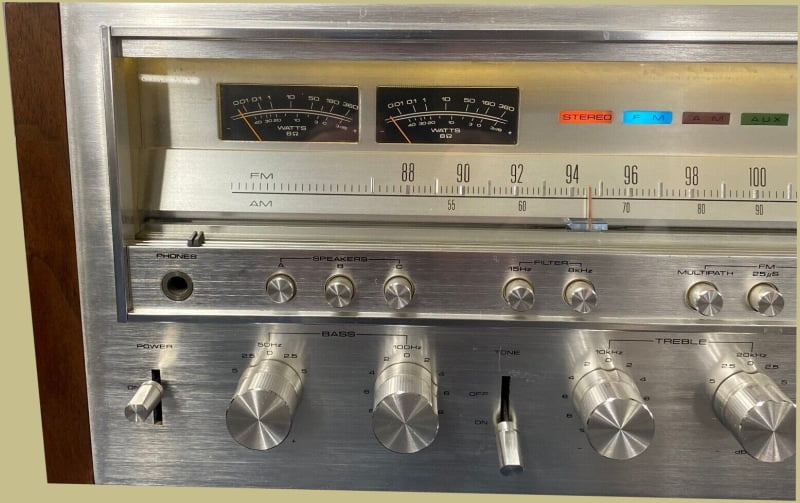
The SX-1280 is a stunning example of Pioneer’s beautiful design work from the 1970’s. The faceplate is brushed aluminum and houses a wide array of controls. The knobs, switch, and buttons are all well designed and situated in eye appealing rows. Given the number of controls the SX-1280 has it’s not surprising that the dial face and meters aren’t very large.
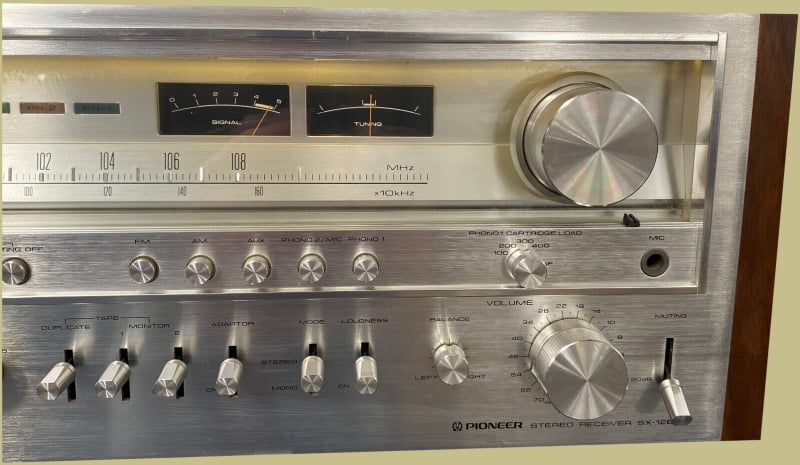
When lit the multi colored function indicator lights and the backlit dial face and meters really give it an elegant look.

The wood case only covers the front half of the stereo. The back half is filled with vents and heat sinks to dissipate the heat the SX-1280 produces.

Here is the layout for the multitude of controls on the Pioneer’s SX-1280.
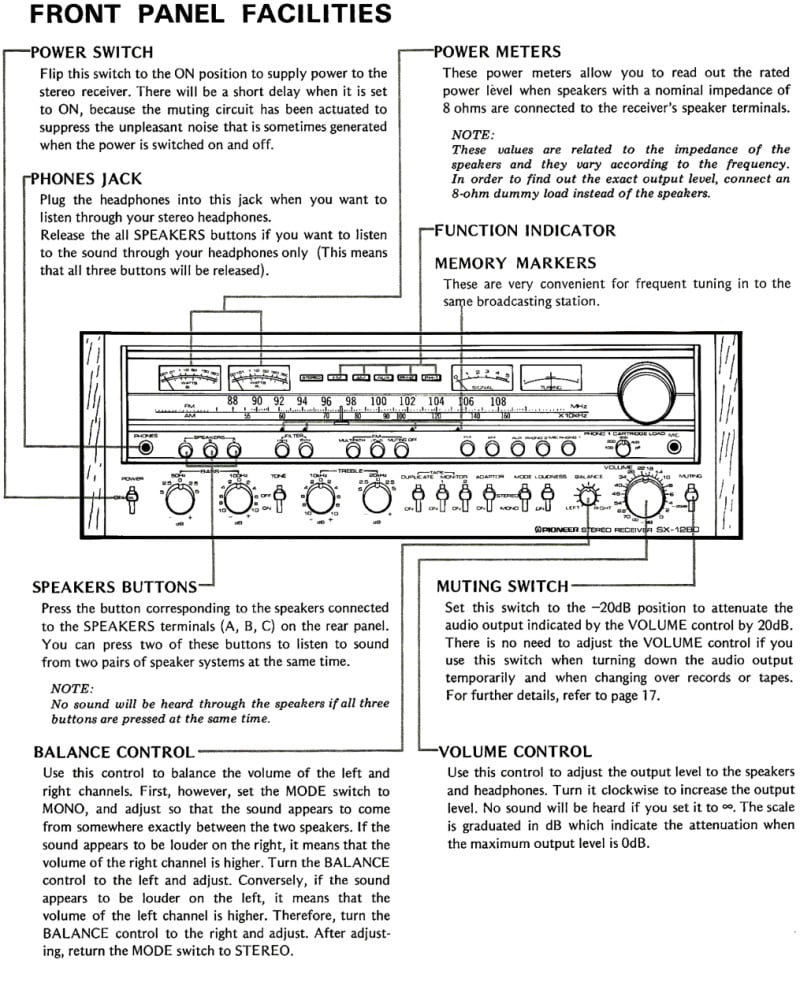
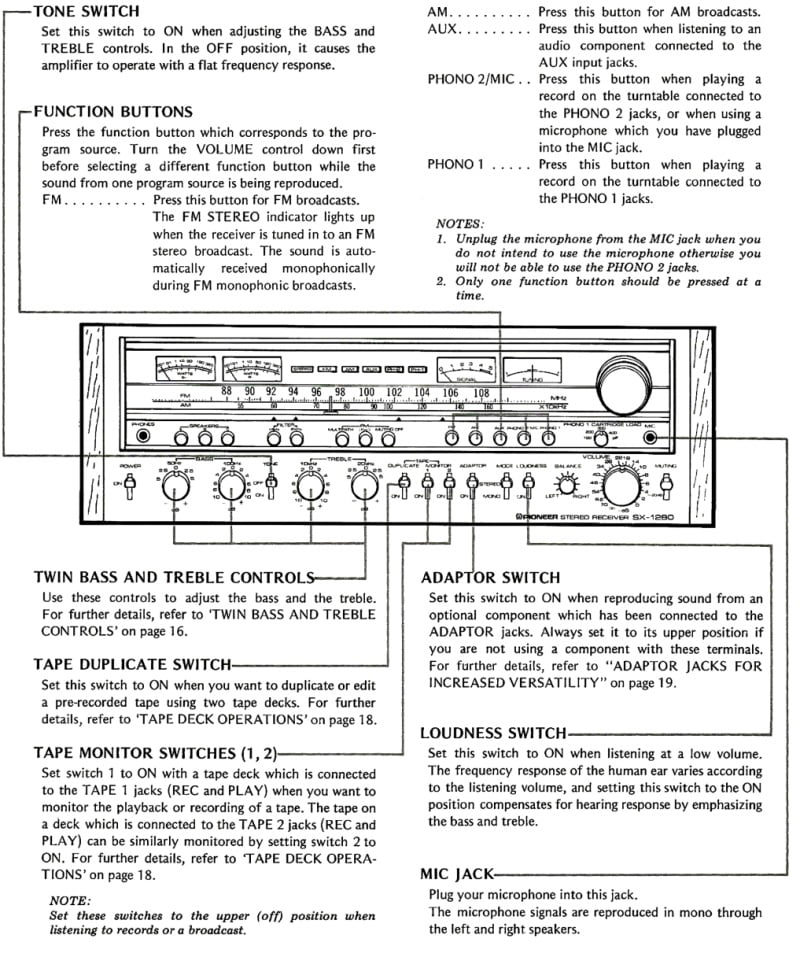
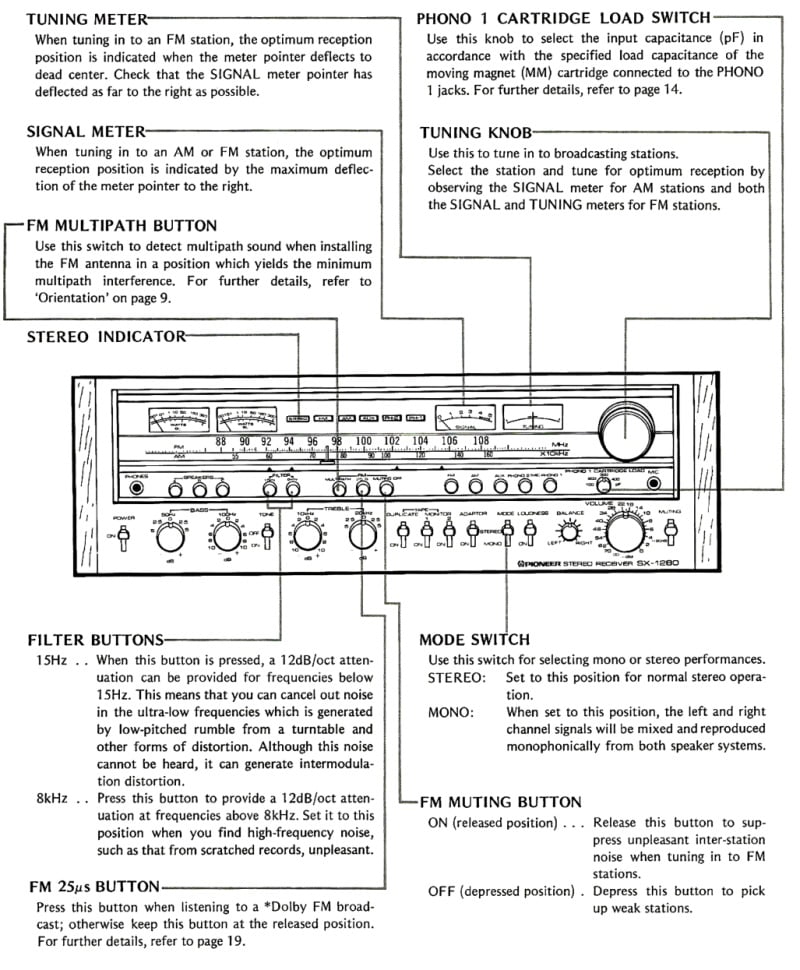

Meters
Power Meters – Each channel has its own power meter (0.01 W – 360W display range) with a logarithmic compression scale. These meters feature a fast response speed, and they enable you to read out the power values at an 8-ohm impedance across a power band stretching from 0.01 W up to the maximum output of the receiver.
Tuning Meter – When tuning in to an FM station, the optimum reception position is indicated when the meter pointer deflects to dead center. Check that the SIGNAL meter pointer has deflected as far to the right as possible.
Signal Meter – When tuning in to an AM or FM station, the optimum reception position is indicated by the maximum deflection of the meter pointer to the right.
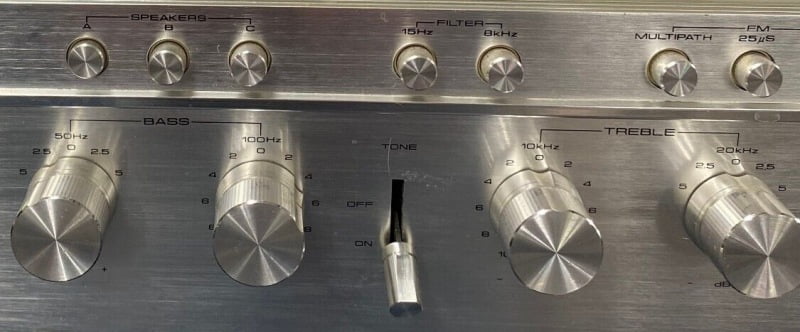
Tone Controls
The SX-1280 has a plethora of tone controls beginning with its Loudness switch and including the Tone switch and its dual Bass and Treble tone controls.
Loudness Switch: Set this switch to ON when listening at a low volume. The frequency response of the human ear varies according to the listening volume, and setting this switch to the ON position compensates for hearing response by emphasizing the bass and treble.
Tone Switch: Set this switch to ON when adjusting the BASS and TREBLE controls. In the OFF position, it causes the amplifier to operate with a flat frequency response.
Twin Bass and Treble Tone Controls:
Pioneer has applied its originally developed twin tone controls to the SX-1280. Along with conventional bass and treble controls, knobs are provided for adjusting the ultra-deep bass and the ultra-high treble independently. By combining the operation of the main and sub tone controls, it is possible to undertake a wide range of tone adjustments. Furthermore, there is an ON/OFF tone control switch which can be used to make the frequency response flat at a moment’s notice and to monitor the acoustics of the listening room, as well as the sound produced by the speakers and phono cartridge.
BASS Controls –
100Hz (main): This control can be used to adjust frequencies lower than 400Hz to enhance or attenuate the frequency by 10dB at 100Hz.
50Hz (sub): This control can be used to adjust frequencies lower than 200Hz which have already been adjusted with the 100Hz control, to enhance or attenuate the frequency by 5dB at 50Hz.
TREBLE Controls –
10kHz (main): This control can be used to adjust frequencies higher than 2.5kHz to enhance or attenuate the frequency by 10dB at 10kHz.
20kHz (sub): This control can be used to adjust frequencies higher than 5kHz which have already been adjusted with the 10 kHz control, to enhance or attenuate the frequency by 5dB at 20kHz.
Using only the main controls provides the same function as conventional audio tone controls. Employing the sub-controls, however, has the same effect as changing the turnover frequencies. The combined operation of both controls will produce a broad range of tone variations.
Specifications –
- Tuning range: FM, MW
- Power output: 185 watts per channel into 8Ω (stereo)
- Frequency response: 5Hz to 80kHz
- Total harmonic distortion: 0.03%
- Damping factor: 30
- Input sensitivity: 7.5mV (mic), 2.5mV (MM), 150mV (line)
- Signal to noise ratio: 80dB (MM), 95dB (line)
- Output: 150mV (line), 1V (Pre out)
- Speaker load impedance: 4Ω (minimum)
- Semiconductors: 5 x FET, 6 x IC, 67 x transistors, 50 x diodes
- Dimensions: 556 x 186 x 461mm
- Weight: 28.7kg
- Accessories: FM T-type antenna
Parts
If you need parts for you’re SX-1280 you can find many of them on eBay:
Manuals can be found on HiFiEngine.
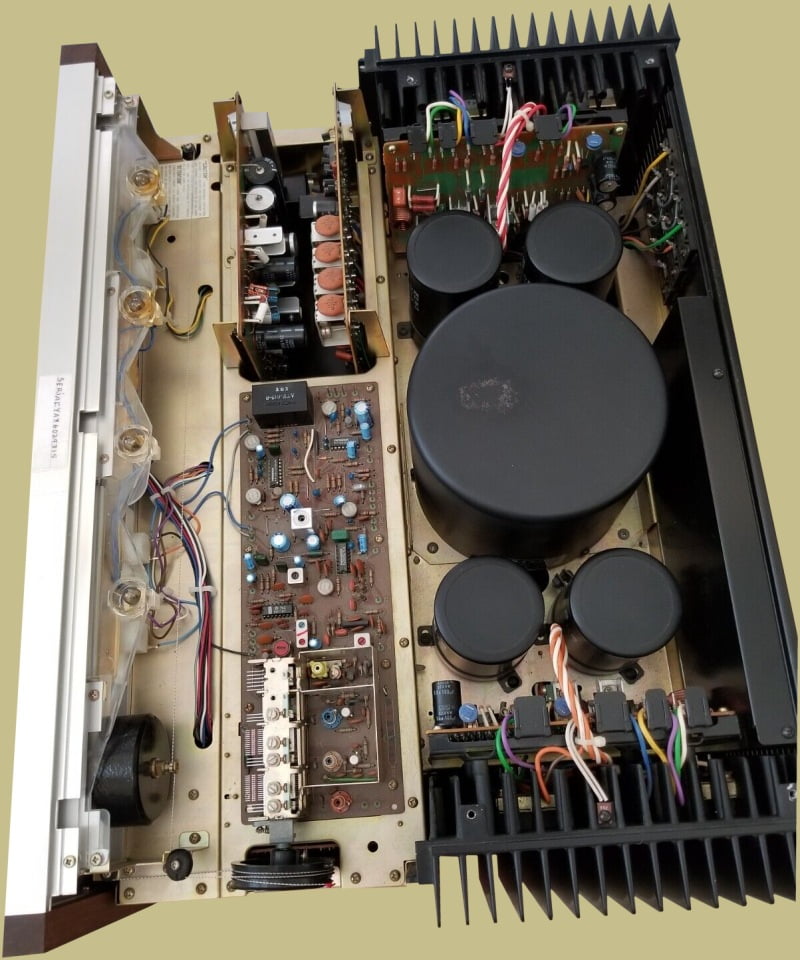
Amplifier
The SX-1280 incorporates a power amplifier with a continuous power output of 185 watts per channel and produces ultra stable sound reproduction. Here are the more technical details:
- The adoption of a single-stage differential amplifier with low-noise dual transistors, a current mirror load and a 3-stage Darlington parallel SEPP circuit provides a bumper power output of 185 watts+185 watts (continuous power output of 185 watts per channel at 8 ohms from 20 Hertz to 20,000 Hertz with no more than 0.03% total harmonic distortion) which is extremely stable. These features guarantee a stable operation at all times from low outputs to high outputs.
- The power amplifier is configured as a DC power amplifier with the capacitors removed from the NFB circuit for a flat gain response all the way from the lowest of the low frequencies up to the audio frequencies. At the same time, the design is engineered for low distortion with the incorporation of what, at the time, were newly developed power transistors.
- The pre-drive stage is a highly dependable amplifier section featuring a power limiter circuit and an overdrive limiter which control the power output so that the power transistors are protected from damage when excessive loads are applied under high power output conditions.
- The large-sized toroidal transformer with its superb regulation employ 15,000uF large-capacity electrolytic capacitors (two for each channel). There are independent dual power supply circuits with separate power transformer windings to provide power for the left and right channels. Together, these two features make for a reproduction of sound that ensures excellent channel separation and ultimate clarity even under high power conditions.
- There is an inrush current suppressor which serves to suppress high-value currents that will charge the power capacitors and also inrush currents from the power transformers. This circuit works to prevent excessive power from being applied to the internal circuitry of the receiver.
Tuning Section
FM Tuner –
- The FM front end incorporates a 1-stage RF circuit that employs a 4-gang tuning capacitor and two dual-gate MOS FETs for high gain and low noise. This configuration rids the sound of undesirable interference for impressive statistics: 1.7/uV (IHF) sensitivity, more than 100dB spurious response ratio and more than 90dB image response ratio.
- The FM IF amplifier combines four dual-element phase-linear ceramic filters with two ICs which contain quadrature detectors for a high selectivity (80dB) and a low distortion (MONO: 0.1% at 1 kHz).
- The stereo demodulator employs an NFB-type PLL MPX IC with a self-contained automatic pilot canceller which automatically cancels out the pilot signals without reducing the high-end frequency. This means that the leak carrier level is amply suppressed for superb separation and flat frequency response in the reproduction frequency band.
AM Tuner –
The tuned AM RF amplifier circuit incorporates a high-sensitivity, low-distortion IC and 2-gang tuning capacitor. These contribute to enhanced imaging and RF interference rejection capabilities. Since the optimum AGC voltage is supplied to each section, stable reception can be obtained with low spurious interference and distortion even in high field strength areas.
Phono Section
Precise Record Equalization –
- A balanced power supply is used in the equalizer amplifier to obtain a maximum allowable input of 300m Vrms (1kHz). Low distortion record playback can thus be enjoyed even with high output phono cartridges and music sources containing large peak signals.
- The equalizer elements which are designed to produce the RIAA characteristics use high precision parts to keep the equalizer deviation between 20Hz – 20kHz down to ±0.2dB for faithful sound reproduction from records.
- Phono 1 Cartridge Load switch: The PHONO 1 input circuit is provided with a cartridge load knob which can be used to obtain the optimum input capacitance (pF) in accordance with the characteristics of the types of cartridges. Moreover, by selecting load capacitances which is beyond the range of those designated, it is possible to produce subtle variations in the sound quality of the phono cartridges.

Other Controls
Adaptor Switch – The SX-1280 has an adaptor switch that should always be set in the upper position when not using any component using the adaptor terminals such as an EQ or Dolby processor.
Filter Switches – There are two filter switches, an 8kHz (high) and a 15Hz (low). The 8kHz (12dB/oct attenuation) switch is useful for eliminating high-range noise such as that produced by scratches on records and hiss. The 15Hz switch is for attenuating at frequencies below 15Hz in order to eliminate ultra-low-range noise generated by warps in the records.

Protection Circuit
In order to protect the speakers and the power transistors, the SX-1280 features a protection IC as well as a special muting circuit that cuts out the noise produced by the on/off operation of the power switch.
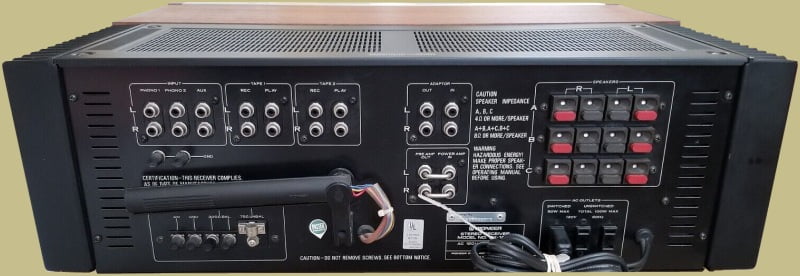
Back Panel
There are connections for three sets of speakers, two turntables, an Aux (CD player or mp3 player), and two tape recorders. There are connections for pre-amp out and power amp in as well.
SX-1250 vs SX-1280
Since the SX-1280 followed the SX-1250 many like to compare them.
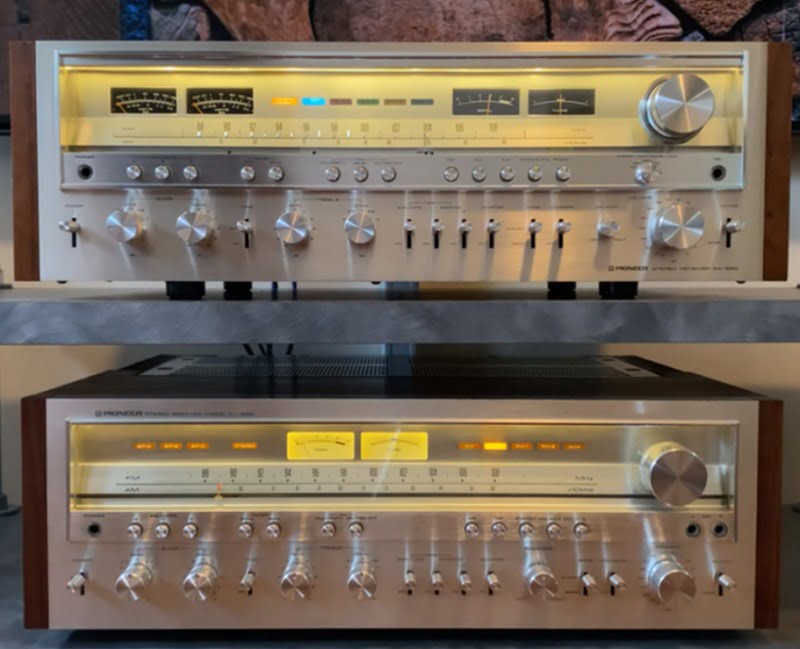
- The SX-1280 is rated at 185 wpc while the SX-1250 is 160 wpc.
- Some tests of fully restored units found both to be roughly the same in power output.
- The SX-1280 has power meters while the SX-1250 does not.
- The SX-1280 has black VU meter faces with white lettering – the SX-1250 has white meter faces and black lettering.
- The SX-1250 is easier to work on than the SX-1280.
- The SX-1250 has shielding on the FM tuning board while the SX-1280 does not.
- They both weigh roughly the same.
- The SX-1280 has some unobtainable parts while parts for the SX-1250 are available.
- Most (not all) feel that the SX-1280 looks better than the SX-1250 (mainly because of the black power meters)
- The SX-1250 sounds a bit better than the SX-1280.
- The SX-1250 is cheaper than the SX-1280 nowadays. Of course, both are pretty expensive.
So, the general consensus is that the SX-1280 looks better but the SX-1250 sounds better.
The SX-1280 is definitely an iconic receiver and considered a monster receiver as well. A fully functional SX-1280 is something to behold. It’s likely that prices for these receivers will continue to rise in the future so if you have a chance to acquire one (or an SX-1250) you should. But, be prepared to shell out some cash as they are not cheap.
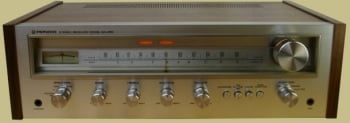
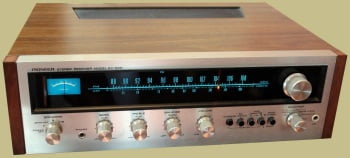
eu gostaria de saber qual o valor desse aparelho. hoje no mercado nacional? alguém sabe me falar. aguardo resposta
obrigado
$1000 to $1900 depending on condition. That’s what has SOLD on eBay in the U.S. recently. Not sure about Portugal.
On September 2019 you can’t touch buying a Pioneer SX-1280 without at very least $2,000.00 to spend. You might find a beat up Pioneer SX-1280 for $2,000.00 and if you are VERY lucky a nice one AT $2K. Most basic vintage Pioneer SX-1280’s without upgrades and repairs sell for $2,100 to $2,400 today. If you want a repaired Pioneer SX-1280 pre prepared to spend $2,400.00 today. A full professionally recapped, upgraded Pioneer SX-1280’s with LED lights can cost close to $3,000. I was lucky I got a clean Pioneer SX-1280 today for just $1,800.00 on Ebay but such finds are rare in 2019.
I purchased my Pioneer SX-1280 on E-Bay December 18 / 2019 for $1900.00 in excellent condition everything working looking like new. I will be taking in to my Technician for a full check up but as of this posting it has been flawless and is a nice addition to my Pioneer SX-1080. I will be adding Led lighting to the dial and indicator lights when I take it for its check up
Hi,
So what model is collectable and does not have the rear shelf like the SX.
Also, a model that is easy to rebulb! Ha.
Thanks
Dave
Yo tengo uno y se proteje es algo leve lo quiero vender
I got my sx1280 for free from an old concrete buddy id help in the winter for some extra cash about 8 years ago we were all hanging out in the garage talking shop and the subject of music was brought up and I said “by the way do any of you guys know where I can buy a nice vintage receiver my dad gave me 4 jbl L100” my buddy said come down stairs and check this out he’s a collector of vintage receivers he had a sansui AU-20000 in its original box and Pioneer sx880, 1080, 1280, and 1980, all bran new looking all gone through from techs and not one hooked up to a speakers. anyways. I asked if he would sale one he said maybe sometime down the road I’ll let you know. 4 years later his business is about over from personal health and hard ships and all his friends/employees for the past 15 years have quit and started there own companies and stole his builders in the process since they were his lead guys made it easy. one did all his flat work, other did his foundations. Thats a pos move if you ask me. I was always there for the guy though any time he needed a slab done or foundation or anything really even helped him move when he lost his house and as we were loading up he said hey I got a present for you pick any receiver and it’s yours but not the sansui lol so I grabbed the sx-1280 sad thing is I used it for about 1 year in the man cave sounds so amazing btw but I just don’t use it anymore so I am going to sell it for a reasonable price since it was a gift to me
Steve, I would be interested in purchasing your SX-1280. I have one already that I purchased brand new in 1979 while in Japan. I would like to have another so as to bridge the amps.
Steve
Is the SX-1280 still available?
If so… Email me back
TIA. Pete
Steve, I am interested in purchasing if it is available.
I bought mine in 1978 while in high school and had kept it pristine. Got married and boxed it in original box with manuals and later a friend wanted to borrow it and 4 years ago his home caught fire and it was destroyed. Heartbreaking.
Terrible
I bought my SX-1280 in 2011 for 800 bucks on eBay. Had to replace a couple burnt out lights and get the front switches looked at. Dirty and that was in. Cosmetically it looked amazing and still does. I’ve used it since 2011 on a regular basis.